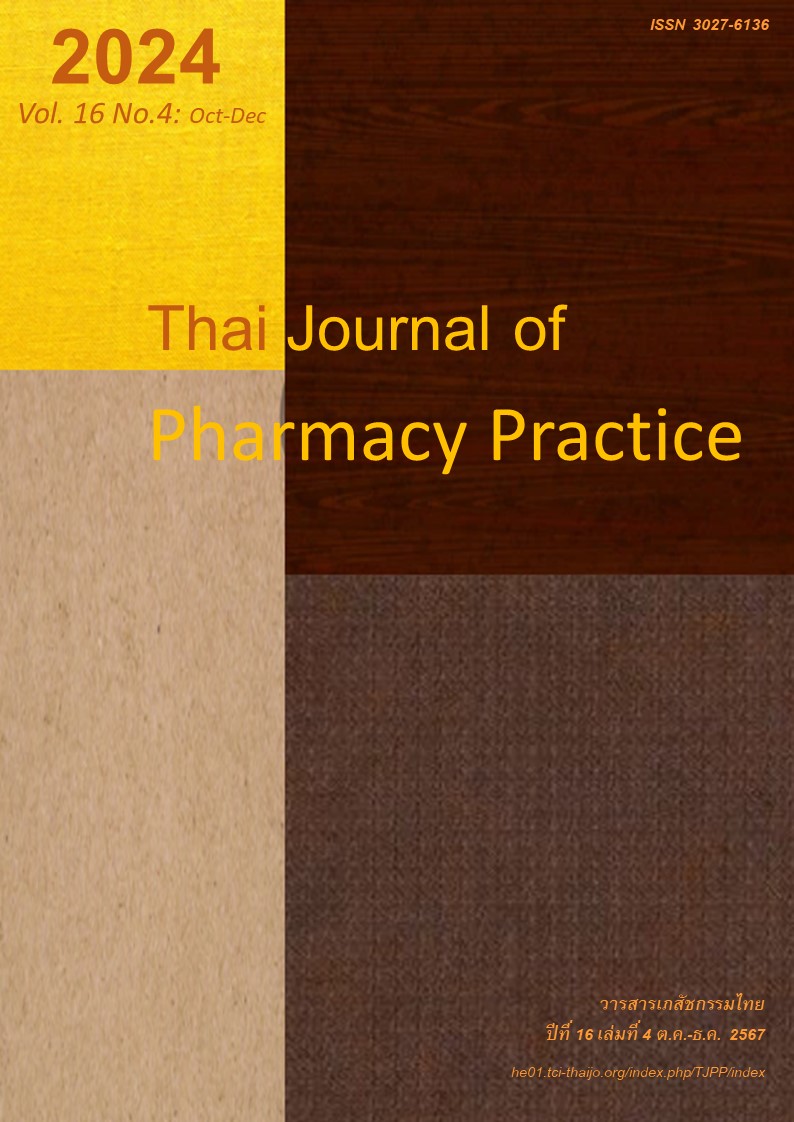ความชุกและปัจจัยที่สัมพันธ์กับเทคนิคการฉีดอินซูลินที่ไม่เหมาะสม
Main Article Content
บทคัดย่อ
วัตถุประสงค์: เพื่อหาความชุกและปัจจัยที่สัมพันธ์กับเทคนิคการฉีดอินซูลินที่ไม่เหมาะสม วิธีการ: การวิจัยเชิงพรรณนาแบบภาคตัดขวางนี้มีกลุ่มตัวอย่าง คือ ผู้มีอายุ 20 ปีขึ้นไปที่เป็นโรคเบาหวานชนิดที่ 2 ที่ฉีดยาอินซูลิน ด้วยตนเองตั้งแต่ 1 เดือนขึ้นไปซึ่งมารับการรักษาจากสถานพยาบาลที่เป็นสถานที่วิจัยในช่วงมีนาคมถึงสิงหาคม พ.ศ. 2564 จำนวน 294 ราย การเก็บข้อมูลทำโดยรวบรวมข้อมูลส่วนบุคคลและการรักษาจากเวชระเบียนและการสัมภาษณ์ เทคนิคการฉีดอินซูลินประเมินจากการสังเกตและสอบถามกลุ่มตัวอย่างขณะสาธิตการฉีดอินซูลิน ผลการวิจัย: กลุ่มตัวอย่างเป็นเพศหญิงร้อยละ 67.3 อายุเฉลี่ย 57.89 ± 10.34 ปี ส่วนใหญ่มีภาวะโรคอ้วน (ร้อยละ 69.7) ระยะเวลาเป็นเบาหวานเฉลี่ย 13.95 ± 8.85 ปี และร้อยละ 85.7 มีระดับ HbA1C ≥ 7 ส่วนใหญ่ใช้ยาฉีดอินซูลินมากกว่า 5 ปี (ร้อยละ 50.7) ได้รับอินซูลินแบบกระบอกฉีดยามากสุดถึงร้อยละ 77.6 และเกิดผลข้างเคียงน้อยกว่าร้อยละ 50 ซึ่งการเกิดรอยช้ำบริเวณที่ฉีดยาพบมากที่สุด (ร้อยละ 44.5) ความชุกของเทคนิคการฉีดอินซูลินที่ไม่เหมาะสมเท่ากับร้อยละ 80.3 ปัจจัยที่สัมพันธ์กับเทคนิคการฉีดอินซูลินที่ไม่เหมาะสม ได้แก่ อายุ (P=0.008) ค่าดัชนีมวลกาย (P=0.036) ระยะเวลาเป็นเบาหวาน (P=0.008) และระยะเวลาใช้อินซูลิน (P=0.014) สรุป: เทคนิคการฉีดอินซูลินที่ไม่เหมาะสมยังมีความชุกสูง บุคลากรทางการแพทย์ควรให้ความสำคัญเรื่องดังกล่าวและจัดให้มีการทบทวนเป็นประจำ ถึงแม้ผู้ที่เป็นเบาหวานจะใช้อินซูลินมาเป็นเวลานานแล้วก็ตาม เพื่อให้ฉีดอินซูลินได้อย่างถูกต้องและเหมาะสม ซึ่งจะช่วยให้ผู้ป่วยควบคุมระดับน้ำตาลในเลือดได้ตามเป้าหมาย และลดความเสี่ยงการเกิดผลข้างเคียงจากอินซูลิน
Article Details

อนุญาตภายใต้เงื่อนไข Creative Commons Attribution-NonCommercial-NoDerivatives 4.0 International License.
ผลการวิจัยและความคิดเห็นที่ปรากฏในบทความถือเป็นความคิดเห็นและอยู่ในความรับผิดชอบของผู้นิพนธ์ มิใช่ความเห็นหรือความรับผิดชอบของกองบรรณาธิการ หรือคณะเภสัชศาสตร์ มหาวิทยาลัยสงขลานครินทร์ ทั้งนี้ไม่รวมความผิดพลาดอันเกิดจากการพิมพ์ บทความที่ได้รับการเผยแพร่โดยวารสารเภสัชกรรมไทยถือเป็นสิทธิ์ของวารสารฯ
เอกสารอ้างอิง
Ekpalakorn V. Annual report of Department of Health 2019-2020. Bangkok: Graphic and Design Typo graphy; 2021.
National Statistical Office. Public health statistics A.D. 2018. Nonthaburi: National statistical office; 2018.
Karnjanapiboonwong A, Kamwangsanga P, Kaewtha S. NCDs status report: diabetes, hypertension and related risk factors in 2019. Bangkok: Graphic and Design Typography; 2020.
Human Resource Strategies and Quality Standards Development Subdivision, Office of Permanent Secretary. Public health statistic [online]. 2016. [cited Aug 29, 2018]. Available from: www.pcko.moph.go. th/Health-Statistics/health_strategy2559.pdf
Diabetes Association of Thailand. Clinical practice guideline 2017.Pathum Thani: Romyen Media; 2017.
Frid AH, Hirsch LJ, Menchior AR, Morel DR, Strauss KW. Worldwide injection technique questionnaire study: injecting complications and the role of the professional. Mayo Clin Proc. 2016; 91:1224-30. doi: 10.1016/j.mayocp.2016.06.012.
Poudel RS, Shrestha S, Piryani RM, Basyal B, Kaucha K, Adhikari S. Assessment of insulin injection practice among diabetes patients in a tertiary healthcare centre in Nepal: a preliminary study. J Diabetes Res. 2017; 2017: 8648316. doi: 10.1155/2017/8648316.
Song Z, Guo X, Ji L, Huang X, Hirsch LJ, Strauss KW. Insulin injection technique in China compared with the rest of the world. Diabetes Ther. 2018; 9: 2357-68. doi: 10.1007/s13300-018-0525-y.
Dagdelen S, Deyneli O, Olgun N, Siva ZO, Sargin M, Hatun S, et al. Turkish insulin injection technique study: population characteristics of Turkish patients with diabetes who inject insulin and details of their injection practices as assessed by survey question naire. Diabetes Ther. 2018; 9: 1629-45. doi: 10.1007/s13300-018-0464-7.
Tosun B, Cinar FI, Topcu Z, Masatoglu B, Ozen N, Bagcivan G, et al. Do patients with diabetes use the insulin pen properly? Afr Health Sci. 2019; 19: 1628-37. doi: 10.4314/ahs.v19i1.38.
American Diabetes Association. Pharmacologic approaches to glycemic treatment: standards of medical care in diabetes—2021. Diabetes Care. 2021; 44(Suppl 1): S113.
Frid AH, Kreugel G, Grassi G, Halimi S, Hicks D, Hirsch LJ , et al. New insulin delivery recommenda- tions. Mayo Clin Proc. 2016; 91: 1231-55. doi:10.101 6/j.mayocp.2016.06.010.
Malithong S, Kumlung C. Evaluations of outpatients’ proper use of insulin injections and counseling by pharmacist in Nopparat Rajathanee hospital. Isan Journal of Pharmaceutical Sciences. 2015;11:58-78.
Jittsue A, Sangjam P, Treesak C, Hanlerdrit T. Assessment of knowledge and practice of patients before and after counseling in the use of the reusable insulin pen at Vachiraphuket hospital. Songklanagarind Medical Journal 2016; 34: 27-37.
Pledger J, Hicks D, Kirkland F, Down S. Importance of injection technique in diabetes. Diabetes & Primary Care 2012; 14: 53-8.
Sanalad R, Phimarn W. Factors affecting of uncontrolled blood glucose, accuracy of insulin injection administration of diabetic patients in Wapipathum hospital. Journal of Science and Technology Mahasarakham University. 2015; 34: 575-86.
Attasuk R, Mato T, Pongpanich P. Incidence and causes of incorrectly insulin injection of patients who visited at diabetic clinic in Jainad Narendra hospital [online]. 2017 [cited Aug 29, 2018]. Available from: www.chainathospital.org/chainatweb/assets/research/research29.pdf.
Cheyoe N. Prevalence and predictors of insulin non-adherence in T2DM. Journal of Health System Research 2016; 10: 333-9.
Stacciarini TS, Pace AE, Haas VJ. Insulin self-administration technique with disposable syringe among patients with diabetes mellitus followed by the family health strategy. Rev Lat Am Enfermagem. 2009; 17: 474-80.
Spollett G, Edelman SV, Mehner P, Walter C, Penfor nis A. Improvement of insulin injection technique: examination of current issues and recommenda- tions. Diabetes Educ. 2016; 42:379-94. doi: 10.1177/ 0145721716648017.
Peyrot M, Rubin RR, Kruger DF, Travis LB. Correlates of insulin injection omission. Diabetes Care. 2010; 33: 240-5. doi: 10.2337/dc09-1348.
Kittipeerachol M, Sirivet P, Suraarunsamrit B, Meka vilai W. Manual of psychiatric patient management for hospitals in the health area. 2nd edition. Bangkok: Victoria Image; 2018.
Sapbamrer R. Quality of research tools. In: Sap-Bamrer R, editor. Research methodology in public health. Bangkok: Odian Store; 2016. p.132-41.
Trief PM, Cibula D, Rodriguez E, Akel B, Weinstock RS. Incorrect insulin administration: a problem that warrants attention. Clin Diabetes. 2016; 34: 25-33. doi: 10.2337/diaclin.34.1.25.
The Pharmacy Council of Thailand. Manual skills guide for professional competency criteria for pharmacy practitioners (2019). Nonthaburi: H R Print and training; 2019.
Siriraj Piyamaharajkarun Hospital. Insulin injection technique [online]. 2019 [cited Mar 27, 2019]. Available from: www.siphhospital.com/th/news/arti cle /share/902/Insulin.
Ongiam A, Wichitwetphaisan P. Quality inspection of research tools. Thai Journal of Anesthesiology. 2018; 44: 36-42.
Medical Technology Research and Evaluation Institute, Department of Medical Services, Ministry of Public Health. Clinical practice guidelines for the management of obesity. Bangkok: Agricultural co-operative federation of Thailand; 2010.
Yuan L, Li F, Jing T, Ding B, Luo Y, Sun R, et al. Insulin injection technique is associated with glycemic variability in patients with type 2 diabetes. Diabetes Ther. 2018; 9: 2347-56. doi: 10.1007/s1330 0-018-0522-1.
Lucidi P, Porcellati F, Marinelli Andreoli A, Carriero I, Candeloro P, Cioli P, et al. Pharmacokinetics and pharmacodynamics of NPH insulin in type 1 diabetes: the importance of appropriate resuspen- sion before subcutaneous injection. Diabetes Care. 2015; 38: 2204–10. doi: 10.2337/dc15-0801.


